Of all the worries pet owners may have around surgery, anesthesia probably tops the list. Unfortunately, their concerns are often the wrong ones. Here are 10 anesthesia myths we hear regularly.
1. Anesthesia is risky
Okay, so this is not a complete myth. Of course there is always a risk with anesthesia, but it’s immensely smaller than most pet owners believe.
Of ALL patients, including the healthiest and the sickest, what percentage of pets don’t make it through anesthesia? 30%? 20%? 10%? 5%? 1%?—what would you guess?
David Brodbelt, a British board-certified anesthesiologist, studied the medical records of over 98,000 dogs and 79,000 cats that underwent anesthesia at over 100 different practices. This was an extravagantly large study by veterinary standards. According to PubMed, Brodbelt found that the “overall risk of anesthetic and sedation-related death in dogs [was] 0.17%...in cats 0.24%.”
As you can see, this indicates that anesthesia is very safe overall—much safer than most would think. With our improved knowledge of anesthesia drugs and excellent advancements in monitoring equipment, the percentage of dogs and cats that die under anesthesia is a fraction of 1%.
Surely, specific conditions (trauma, diseases and infections) can increase the risks, but these issues are more manageable than you might think. By performing pre-operative blood work and tailoring the anesthesia drugs for each pet, veterinarians can minimize the risks.
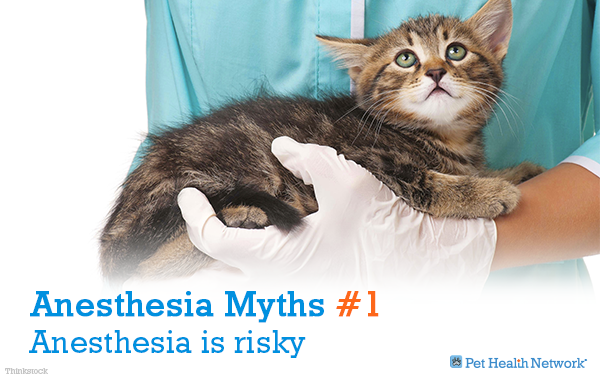
2. Most complications occur during surgery or while under anesthesia
Here’s a great example of a classic urban legend. Most of the time, the biggest risks are not during surgery and anesthesia but during recovery.
As a pet awakens, there are a number of complications that can arise. In the Brodbelt study I mentioned earlier, over 50% of pets who died after surgery, died within 3 hours of the procedure ending; this is why it is critical to take your pet to a hospital where trained nurses will continue to closely monitor your pet after anesthesia.
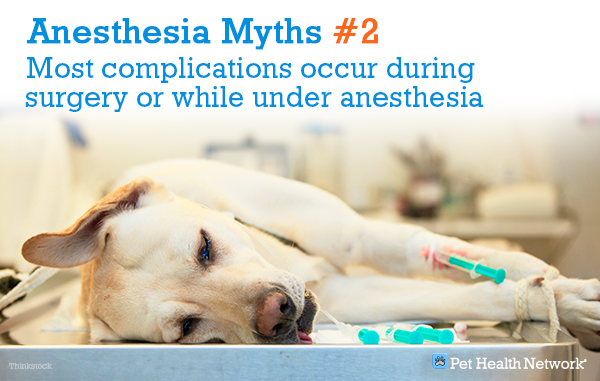
3. All vets offer and practice the same anesthesia techniques
Actually, every veterinarian seems subject to personal opinion when it comes to anesthesia; the same way everyone has their own personal preference when it comes to cars. Some people want a Ford, while others only buy Honda, but ultimately both cars will get you from point A to point B. Similarly, different veterinarians will use different methods. Naturally they’ll choose the methods that they are the most knowledgeable and comfortable with and that they feel are safest for your pet based on blood work, physical examination, disease, breed, age etc.
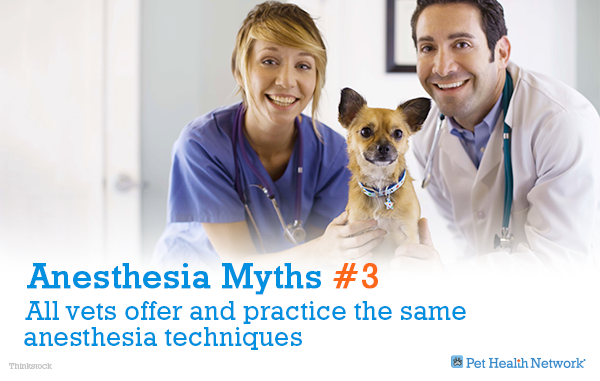
4. Anesthesia drugs can harm my pet
While all medications—even a “simple” antibiotic—have risks, very few pets will experience an unexpected reaction. Each drug has its time and place, which is why pre-operative examination, basic blood work and sometimes additional lab work are important before surgery.
Additionally, it may be possible to temper the side-effects of some drugs. For example, some anesthesia drugs can indirectly affect the kidneys, which can be protected by keeping the patient on the proper amount of IV fluids.
Please remember, anesthesia is very safe overall. What matters most is the nature of the drugs used, the knowledge of the people using them and the care provided to patients when they wake up from anesthesia.
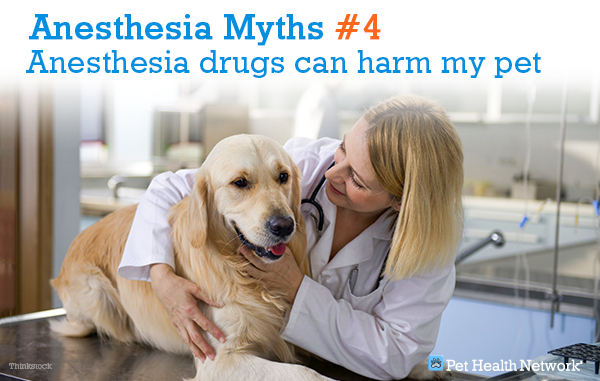
5. My pet is too young for anesthesia
Young patients do present the veterinarian and their staff with a bit more of a challenge compared to adults. Pediatric pets are typically smaller and more sensitive, so they need anesthesia techniques and protocols to be tailored for them. For example, because of their (usually) smaller size, they lose heat quicker so their temperature has to be closely monitored and specific techniques should be used to keep them warm.
Young patients also have fewer energy reserves than adults. This is the reason why your veterinarian may recommend a small meal the morning of anesthesia, whereas adults should be completely fasted overnight.
Youth is not a reason to avoid anesthesia; however, your veterinarian should make sure pediatric patients are kept warm, vital signs are closely monitored and anesthetic drugs are chosen wisely.
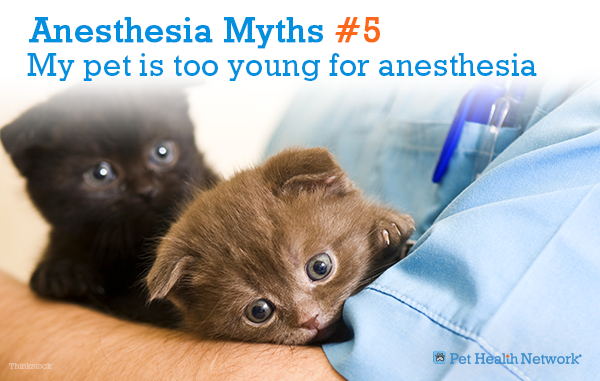
6. My pet is too old for anesthesia
This is another big misconception. Old age is basically never a reason not to perform a surgical or medical procedure. Sure, it may be an issue in the owner’s mind, but rarely in the veterinarian’s opinion.
Thanks to the advances in veterinary medicine, pets enjoy longer lives now than ever before. Although, like humans, As pets age their bodies change—resulting in a slower metabolism, greater sensitivity to medications and slower healing time.
Geriatric patients often do need some additional pre-anesthesia screening including blood work, chest radiographs (to ensure their lungs are free of disease or cancer) and an EKG to confirm they do not have any major heart problems. Once their overall health status has been assessed, the veterinarian can decide on any pre-anesthesia supportive care or medications. Anesthesia drugs should then be chosen to minimize side-effects for geriatric pets based on their specific condition.
My philosophy is simple: age is not a disease! Cancer is a disease, a uterus full of pus (pyometra) is a disease, and a gallbladder about to burst is a disease; but age by itself is not.
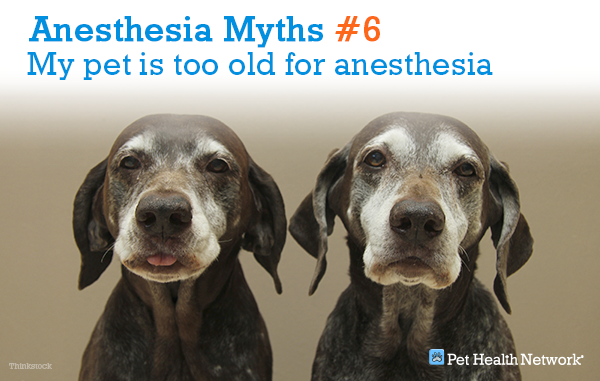
7. My pet is too sick for anesthesia
Certainly some patients are so sick that anesthesia should be postponed until they are more stable, if at all possible. Stabilizing a patient may mean administering IV fluids or specific drugs. Once they are more stable, anesthesia can be performed.
Your veterinarian will carefully evaluate your pet’s blood work and physical health status to determine if he is stable enough to be anesthetized, or what stabilization treatments are needed first.
In some extreme or emergency situations, we may have no choice. A very sick patient may need to undergo anesthesia immediately to have the surgery that will make him feel better or save his life. For example, if a dog “bloats” or presents with a hugely distended or twisted stomach, he will need surgery as soon as possible. I will, however, give large volumes of IV fluids before anesthesia starts.
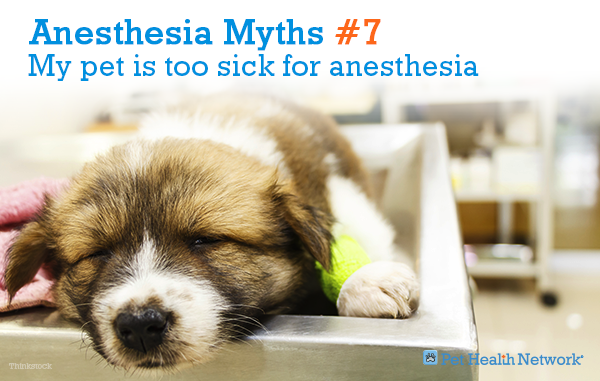
8. My pet will be groggy for days after having anesthesia
This concern is more often false than true. Sure, every pet, like every human, handles anesthesia differently. Even if two patients are given the same anesthesia drugs and undergo the same procedure, one may recover very quickly and act like nothing ever happened while the other may recover slowly and still seem a little groggy for a day or two.
If your pet seems groggy a few days after a procedure, it is important to let your veterinarian know; your vet can look up records to see what drugs were used and adjust accordingly with alternate drugs or lower dosages.
A sleepy pet may be a sign of an underlying condition. However, in most cases, pets are not really groggy from the anesthesia; rather they’re groggy from their pain medications, which can sometimes cause sedation. Most modern anesthesia drugs are processed by the body within minutes to hours. Again, please double check with your veterinarian.
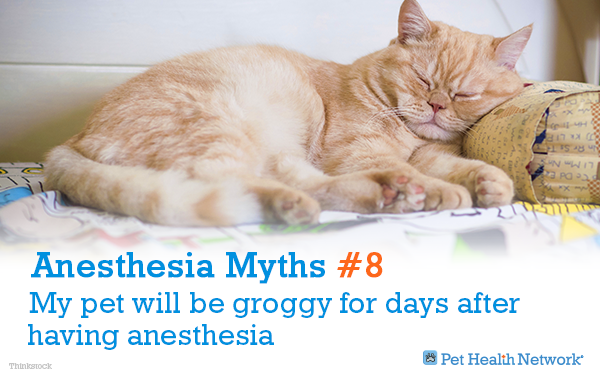
9. My pet is too sick for anesthesia
Many pet owners think that their dog or cat cannot be placed under anesthesia repeatedly in a short span of time. While ideally your pets would not need frequent anesthesia, here are examples of times when they may:
- When pets get radiation therapy to treat cancer, their position has to be exactly the same to irradiate the tumor in the same manner every time. Since pets won’t hold still long enough, this means they have to be anesthetized for every session. The “standard” protocol is to put them under anesthesia 5 days a week for 4 weeks. That’s 20 anesthesia episodes within one month. And most do very well, even though many of these cancer patients are very sick already.
- A more common situation might be taking X-rays under sedation on a Monday, fixing a broken bone under anesthesia on a Tuesday and changing a bandage under sedation on a Wednesday. These days, there are many options for very safe drugs to perform sedation or anesthesia. These drugs leave the body quickly, so they have few harmful effects. Some drugs can even be “reversed,” which means that we can give sort of an antidote to wake the patient up.
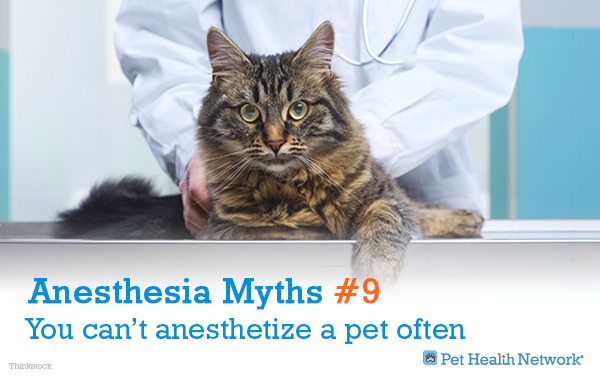
10. There is no danger
While my intention with these blogs is to show you that anesthesia is safe most of the time, some pet owners seem to take it for granted. Whether a procedure is performed under sedation or anesthesia and despite a pre-surgical exam, blood work and sometimes further diagnostic tests, any pet could have a rare reaction to a medication.
This doesn’t mean that you should be overly paranoid. All it means is that anesthesia should be taken seriously, and that you should talk with your veterinarian before your pet is sedated.
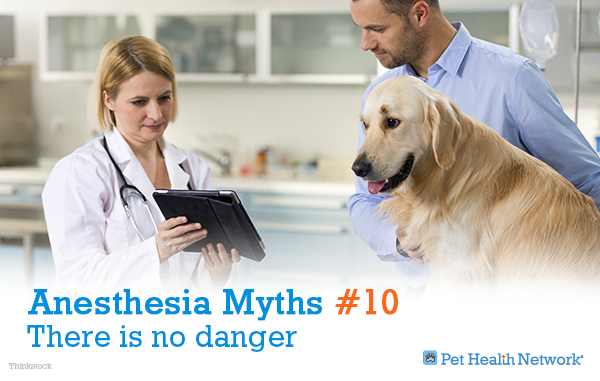
If you have any questions or concerns, you should always visit or call your veterinarian -- they are your best resource to ensure the health and well-being of your pets.
